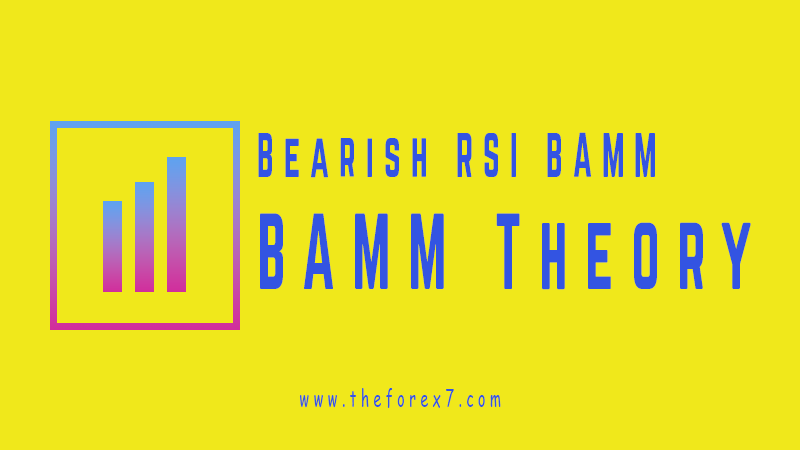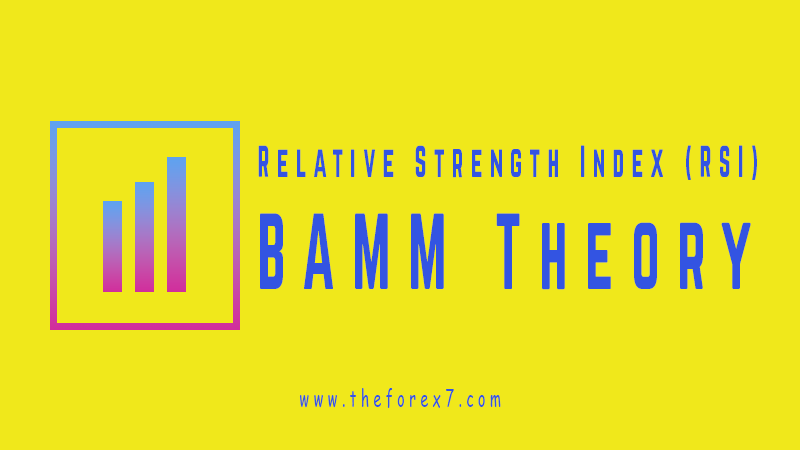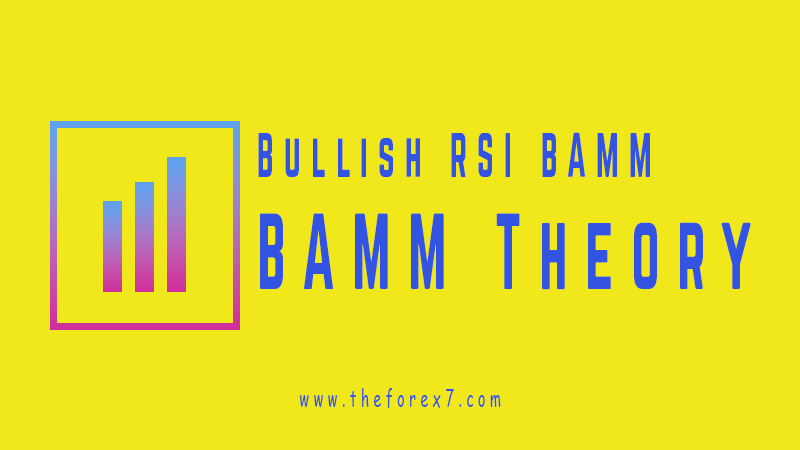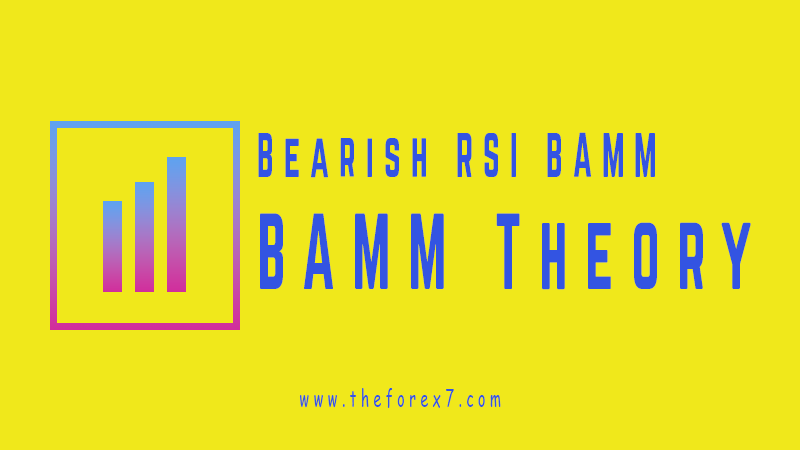Bearish RSI BAMM: Bearish Butterfly, Bearish BAT
Define Bearish Butterfly, Define Bearish BAT, Bearish BAT at RSI BAMM, Bearish trigger bar signals, Harmonic Trading Strategy
Course: [ HARMONIC TRADING : Chapter 6: RSI : Relative Strength Index (RSI): BAMM Theory ]

Although the position of the RSI BAMM Trigger Bar in relation to the prior high defines the execution area of the completion of the RSI BAMM, the formation of distinct harmonic patterns during this final divergence stage is the defining confirmation signal for the execution of the trade.
PATTERN COMPLETION AT THE 1.13–1.618 RSI BAMM EXTENSION AREA
Although
the position of the RSI BAMM Trigger Bar in relation to the prior high defines
the execution area of the completion of the RSI BAMM, the formation of distinct
harmonic patterns during this final divergence stage is the defining
confirmation signal for the execution of the trade. The pattern’s PRZ combined
with the RSI BAMM extension provides significantly more accurate technical
evidence of a probable reversal at hand. Although the execution of the trade is
more dependent upon the completion of the pattern, the RSI BAMM extension is a
critical minimum technical level that must be tested. Most importantly, the key
to this final phase is to be patient and wait for distinct patterns to develop
in these areas.
BEARISH BUTTERFLY AT 1.13 RSI BAMM CONFIRMATION POINT
One
of the most common patterns associated with a 1.13 RSI BAMM Confirmation Point
extension is a Bearish Butterfly (see Figure
6.67). Typically, the RSI BAMM Trigger Bar will indicate a 1.13 extension,
while the price action forms a distinct Bearish Butterfly, indicating that the
potential reversal will occur at the 1.27 extension.

FIGURE 6.67
Although
this may create some confusion, it is important to remember that the pattern
completion point represents the most critical price level in this area. This
underscores the importance of the PRZ within the RSI BAMM limits (1.13–1.618)
as the most critical price area for the ultimate execution of the trade.
BRITISH POUND/USD
(GBP_A0-FX): WEEKLY
BEARISH BUTTERFLY
AT 1.13 RSI BAMM CONFIRMATION POINT
Referring
back to our weekly example of the British Pound, the Bearish Butterfly clearly
complemented the RSI BAMM Confirmation Point. Although the 1.13 extension was
slightly below the pattern’s PRZ, the combination of the Bearish Butterfly and
the Bearish RSI BAMM defined critical long-term resistance in the 1.95–1.96
area on the weekly chart.
The
chart in Figure 6.68 shows the indicator
and price action that possesses a distinct bearish harmonic pattern at the RSI
BAMM Confirmation Point.

FIGURE 6.68
BRITISH POUND/USD
(GBP_A0-FX): WEEKLY
BEARISH BUTTERFLY
POTENTIAL REVERSAL ZONE (PRZ) AT 1.13 RSI BAMM CONFIRMATION POINT
The
enlarged chart in Figure 6.69 of the
British Pound shows the PRZ of the weekly Bearish Butterfly at the 1.13 RSI
BAMM Confirmation Point.

FIGURE 6.69
Clearly,
the PRZ of the pattern with the RSI BAMM Confirmation Bar identified critical
long- term resistance, as the British Pound reversed sharply in the weeks
following the completion of the setup.
ALTERNATE BEARISH BAT AT 1.13 RSI BAMM CONFIRMATION POINT
Although
a Bearish Butterfly possesses powerful harmonic implications at the 1.13 RSI
BAMM Confirmation Point extension, there are many instances where an Alternate
Bat Pattern may be the only structure forming at the completion of the setup (see Figure 6.70).

FIGURE 6.70
In
the case of the Alternate Bat, the completion of the setup will typically
reverse very close to the 1.13 extension. It is important to focus on this
extension level and the RSI Confirmation Point for an indication that the
reversal has completed. As long as the other elements of the RSI BAMM and the
pattern alignment complete in the same area, the trade execution at the 1.13
extension is valid.
On
a side note, you may be wondering about other retracement patterns like the
Gartley or the Bat that may form in conjunction with a 1.13 extension. Although
these patterns will typically complete before the 1.13 extension, the position
of their RSI BAMM Trigger Bar will typically be 5 or more price bars from the
prior high. I will show an example a bit later in this chapter. As for the
Alternate Bat pattern, the Trigger Bar will typically be 3–4 price bars from
the prior high.
STANDARD AND POOR’S 500 ETF (SPY): 5-MINUTE ALTERNATE BEARISH BAT AT RSI BAMM CONFIRMATION POINT
The
chart of the SPY in Figure 6.71
shows a distinct RSI BAMM setup with a Bearish Alternate Bat converging at the
Completion Point. The price action reversed sharply after testing the PRZ and
the overbought 70 limit. The precise reversal and decisive continuation
following the completion of the setup were clear signs of a valid reversal at
hand.

FIGURE 6.71
Although
the SPY reversed just shy of the 1.13 extension, the price action tested most
of the PRZ at the same time it completed the impulsive retest at the RSI
Completion Point. Again, the coordination of these technical events is the
defining element of all valid reversals. When the completion of the pattern
occurs simultaneously with the RSI retest, the reversal is likely to yield a
significant move.
STANDARD AND POOR’S 500 ETF (SPY): 5-MINUTE ALTERNATE BEARISH BAT POTENTIAL REVERSAL ZONE (PRZ) AT RSI BAMM CONFIRMATION POINT
The
enlarged chart in Figure 6.72 of the
Alternate Bearish Bat PRZ at the RSI BAMM Confirmation Point reveals the ideal
elements for a valid reversal. The price action stalled immediately in the PRZ
and exemplified the model technical coordination between the completion of the
pattern and the RSI BAMM.

FIGURE 6.72
The
SPY “kissed” the 70 level on the RSI retest as the pattern
completed. In addition, the overwhelming downside continuation following the
completion of the setup helped to quickly confirm its validity.
PATTERN COMPLETION BEFORE 1.13–1.618 RSI BAMM EXTENSION AT CONFIRMATION POINT: BEARISH BAT
The
Bearish Bat structure that completes at an RSI Confirmation Point offers a
unique trade opportunity. The structure of the pattern is extremely important
to distinguish the optimal execution for the trade. The price action will
usually test the PRZ and the overbought extreme zone before an execution signal
is generated. The impulsive retest will occur at the 0.886 retracement—not the
minimum 1.13 RSI BAMM extension (see
Figure 6.73).

FIGURE 6.73
Although
the Trigger Bar high point resistance (dotted line) complements this area, the
coordination of these two technical events is critical in determining the minor
reactive moves from the major reversals.
STANDARD AND POOR’S
500 MARCH 2010 MINI-CONTRACT (ES_H0): 15-MINUTE
BEARISH BAT AT RSI
BAMM EXTENSION
Figure 6.74
shows a Bearish Bat that completed in conjunction with the RSI BAMM
Confirmation Point (see Figure 6.74).
The interesting aspect of this situation was the slightly delayed test of the
PRZ, as the price action tested the RSI BAMM Completion Point well before the
ultimate reversal.

FIGURE 6.74
STANDARD AND POOR’S
500 MARCH 2010 MINI-CONTRACT (ES_H0): 15-MINUTE
BEARISH BAT
POTENTIAL REVERSAL ZONE (PRZ) AT RSI BAMM CONFIRMATION POINT
Figure 6.75
shows an enlarged chart of the price action the PRZ. Although the RSI rolled
over much earlier, this example underscores the need to coordinate the pattern
completion with the indicator divergence. Also, this situation demonstrates
that the RSI BAMM completion is a minimum technical signal and relies on the
completion of the pattern to dictate when and where to execute the trade.

FIGURE 6.75
PATTERN COMPLETION BEFORE 1.13–1.618 RSI BAMM EXTENSION AT CONFIRMATION POINT: BEARISH GARTLEY
In
the case of the Bearish Gartley, the structure of the pattern is extremely
important. Although the PRZ is typically well below the minimum 1.13 RSI BAMM
extension, this situation still relies on coordinating the completion of the
pattern with the final impulsive indicator retest (see Figure 6.76).

FIGURE 6.76
Although
the Trigger Bar high point resistance (dotted line) complements this area, the
coordination of these two technical events is most critical in validating the
best trade opportunities.
EURODOLLAR
(EUR_A0-FX): 5-MINUTE
BEARISH GARTLEY AT
RSI BAMM EXTENSION
In
this example, the price action possessed a distinct bearish Gartley pattern
that completed in conjunction with the RSI BAMM Confirmation Point (see Figure 6.77).

FIGURE 6.77
Although
the Euro rallied sharply as it tested the PRZ, the price action stalled
immediately after hitting the overbought 70 level at the RSI BAMM Confirmation
Point.
EURODOLLAR
(EUR_A0-FX): 5-MINUTE
BEARISH GARTLEY
POTENTIAL REVERSAL ZONE (PRZ) AT RSI BAMM CONFIRMATION POINT
The
price action the PRZ is illustrated particularly well on the enlarged chart in Figure 6.78. The arrow points to where
the RSI BAMM Confirmation Point completed.

FIGURE 6.78
Both
technical events of the pattern’s completion and the successful impulsive RSI
retest occurred nearly on the same day. This situation exemplifies the type of
coordination between the two approaches that yields the best trading
opportunities.
PATTERN COMPLETION BEFORE 1.13–1.618 RSI BAMM EXTENSION AT CONFIRMATION AREA: BEARISH 5-0 PATTERN
The
Bearish 5-0 pattern is probably the most difficult to incorporate with the RSI
BAMM. This is due simply to the fact that the completion of the pattern occurs
nowhere near the minimum 1.13 RSI BAMM extension (see Figure 6.79).

FIGURE 6.79
As
is the case with all harmonic patterns in the RSI BAMM setup, coordination is
the key. The best 5-0 patterns require a distinct price structure that must
complete in tandem with the RSI BAMM Confirmation Point. It is important to
focus on the completion of the impulsive RSI retest, as this will typically be
the most significant signal within the PRZ of the pattern.
GOOGLE (GOOG): 15-MINUTE PATTERN COMPLETION BEFORE 1.13–1.618 RSI BAMM EXTENSION AT CONFIRMATION AREA: BEARISH 5-0 PATTERN
The
intra-day chart of Google in Figure 6.80
shows a distinct Bearish 5-0 pattern that completed simultaneously with the RSI
BAMM Confirmation Point. The successful reversal following the impulsive retest
at the Confirmation Point was a definitive signal to confirm the execution of
the short position in the PRZ of the 5-0 pattern.

FIGURE 6.80
Although
the typical 1.13 or 1.618 extension does not factor into these situations, the
coordination of the impulsive RSI retest and the completion of the pattern
continually provides accurate signals and effectively filters the best setups.
Therefore, the 5-0 relies on the coordination of the indicator readings and the
price action more than any other pattern applied to the RSI BAMM approach.
1.618 EXTENSION AT RSI BAMM CONFIRMATION POINT
The
general rule for the Confirmation Point extension must focus on the location of
the Trigger Bar, as it relates to the extreme prior peak. If the RSI BAMM
Trigger Bar is the high price bar, the 1.618 extension is utilized to quantify
the execution area for the trade (see
Figure 6.81).

FIGURE 6.81
The
two patterns that are utilized in these situations are the Bearish Crab and the
Deep Bearish Crab. The following case studies are fantastic examples of pattern
completions within the final phase of the RSI BAMM that converge with a 1.618
Confirmation Point. Although the 1.618 extension is the most critical harmonic
number in this setup, the PRZ of the pattern defines the exact price range to
execute the trade but still relies on the coordination of the RSI BAMM
Confirmation Point to optimize trading decisions.
BEARISH CRAB AT 1.618 RSI BAMM CONFIRMATION POINT
In
the Bearish RSI BAMM, the general rule for the Confirmation Point extension
must focus on the location of the Trigger Bar, as it relates to the extreme
prior low. If the Bearish RSI BAMM Trigger Bar is the extreme high, the 1.618
extension is utilized to quantify the Confirmation Point and the execution area
for the trade (see Figure 6.82).

FIGURE 6.82
Although
other factors will be considered, the importance of the extreme high to signal
a 1.618 RSI BAMM extension helps to define the ultimate execution point for the
trade. Two patterns—the Bearish Crab and the Deep Bearish Crab—utilize the
1.618 extension. Regardless of which Crab defines the PRZ, the crucial
technical event occurs when the price action tests this area at the same time
it completes the RSI BAMM Confirmation Bar.
FAMILY DOLLAR
(FDO): DAILY
BEARISH CRAB WITH
BEARISH RSI BAMM
The
daily chart of Family Dollar in Figure
6.83 shows a Bearish Crab that completed with a distinct Bearish RSI BAMM
setup. Since the extreme prior high at the X point represented the Trigger Bar,
the ultimate completion occurred at the 1.618 extension.

FIGURE 6.83
The
stock reversed immediately after testing the 1.618 RSI BAMM Completion Point.
The decisive downside continuation accelerated after the RSI impulsive retest
reversed from the 70 level. Again, the coordination of the reversal in both the
pattern and the RSI BAMM signaled a valid setup at hand.
DEEP BEARISH CRAB AT 1.618 RSI BAMM CONFIRMATION POINT
Similar
to the 1.13 RSI BAMM extension, the 1.618 extension is dictated by the position
of the Trigger Bar. In this case, a Trigger Bar that is the extreme prior high
will result in a corresponding pattern that utilizes a 1.618 projection. Within
the Harmonic Trading arsenal of patterns, this will usually manifest as a Crab
or Deep Crab pattern.
The
Deep Bearish Crab presents a unique situation at the RSI BAMM Completion Point
(see Figure 6.84). The 1.618 extension is the defining level for both the
completion of the pattern and the RSI BAMM. In these situations, the 1.618
extension becomes even more significant, and the price action should not exceed
this resistance level. Furthermore, most valid reversals will occur quickly
after this area has been tested.

FIGURE 6.84
BOEING (BA): DAILY
DEEP BEARISH CRAB
WITH BEARISH RSI BAMM
The
Boeing chart in Figure 6.85 shows
the entire RSI BAMM and the distinct Bearish Crab that formed during the
divergence phase of the RSI BAMM. Although there were other numbers in the PRZ
to complement this harmonic resistance, the 1.618 extension was the defining
technical level in the setup. The convergence of the completion of the pattern
with the impulsive RSI retest marked a critical reversal for the stock on the
daily chart.

FIGURE 6.85
Although
the RSI BAMM Confirmation Point completed before the entire test of the PRZ,
both methods indicated the distinct area where this trend would change. In
addition, this example of Boeing truly shows how distinct harmonic patterns
that form in the final phase of the RSI BAMM can pinpoint precise reversal
zones.
BOEING (BA): DAILY
DEEP BEARISH CRAB
POTENTIAL REVERSAL ZONE (PRZ) AT 1.618 RSI BAMM CONFIRMATION POINT
The
enlarged chart in Figure 6.86 of the
price action in the PRZ at the RSI BAMM Confirmation Point clearly shows how the
uptrend stalled as it tested this area and rolled over shortly after completing
the pattern.

FIGURE 6.86
On
a side note, the impulsive RSI retest reading literally kissed the 70 limit and
reversed. These situations may be difficult to assess because the RSI BAMM
Confirmation Point typically involves a sharp and brief indicator test.
Although these situations may be tricky, the PRZ of the pattern serves to
indicate the optimal price level for the trade execution. Remember, both
conditions of a pattern completion and a successful test of the Confirmation
Point are required to validate the entire RSI BAMM setup.
RSI BAMM CONFIRMATION POINT—REVERSAL ACCELERATION TRIGGER
An
additional technical trigger serves as a secondary confirmation. Although this
final trigger does not develop in every situation, when present after the final
test of the Confirmation Point, it typically represents an area of acceleration
of the reversal.
BEARISH CONFIRMATION POINT—REVERSAL ACCELERATION TRIGGER
The
important focus of this Acceleration Trigger is the impulsive test of the RSI
in conjunction with the price action. The structure of the RSI reading is
critical after it sinks below the 70 level, as it can offer an important
technical trigger that marks the area where the reversal should begin to
accelerate (see Figure 6.87).

FIGURE 6.87
Typically,
the RSI reading forms a brief “corrective pause” before
accelerating to the downside. This “corrective pause” usually
occurs within a few price bars of the breakdown. The trigger is determined by
the price bar that results in the (accelerated) breakdown of the indicator
reading following the completion of the RSI BAMM Confirmation Point.
It
is important to expect that the RSI trigger signal will develop before the
price begins to move. Although the RSI trigger is a bit early, the RSI BAMM
Acceleration Trigger marks the most critical area within the entire strategy.
This price level marks where an acceleration of the reversal price action must
occur at this point or shortly thereafter. After the reaction from the
overbought area, the indicator reading of the final RSI BAMM Confirmation Point
should accelerate decidedly following the impulsive test of this last phase. In
particular, the structure of the RSI reading is critical after it sinks below
the 70 level, as it must demonstrate a decisive continuation of the reversal
trend. Specifically, an M-type formation following the impulsive RSI test at
the Confirmation Point should serve as an acceleration level that marks the beginning
of the new trend.
The
magnified illustration of the Bearish RSI BAMM Confirmation Point in Figure 6.88 clearly shows the ideal
indicator structure that serves as a definitive confirmation trigger. It is
important to note that the ideal structure is more visibly seen in the RSI than
the price. Sometimes, the initial pullback following a reversal from the RSI
BAMM Confirmation Point may only be a one or two bearish price bar pause, but
the internal action is weakening. Although waiting for this trigger may delay
an execution, the extra confirmation does provide a reliable signal of a valid
reversal at hand. Furthermore, this breakdown of the Acceleration Trigger
prevents executions at invalid RSI BAMM Confirmation Points, where the
impulsive test at the 70 level flounders and does not provide decisive reversal
continuation.

FIGURE 6.88
In
these situations, it is important to respond appropriately and exit the trade
at a small loss or break even due to the fact that the price action languishes
after completing the RSI BAMM Confirmation Point.
The
price action should move quickly and decidedly after the Acceleration Trigger
is confirmed. The price bar that completes the breakdown of the M-type
structure in the RSI reading will typically mark the acceleration point of the
new reversal trend. When this trigger materializes, it creates a “do-or-die”
situation while possessing powerful price action signals. In fact, the
Acceleration Trigger represents the most sophisticated technical setup within
the entire Harmonic Trading approach.
GOOGLE (GOOG):
5-MINUTE
BEARISH 5-0 PATTERN
POTENTIAL REVERSAL ZONE (PRZ) AT RSI BAMM CONFIRMATION POINT WITH ACCELERATION
TRIGGER
Referring
back to the example of the Bearish 5-0 pattern in Google in Figure 6.80, the
stock reversed precisely after hitting the entire PRZ at the same time the RSI
completed a successful impulsive retest of the overbought extreme limit above
the 70 level (see Figure 6.89).

FIGURE 6.89
The
Acceleration Bar completed an M-type structure after the indicator reading
broke down under the 70 level. This extra signal effectively indicated the area
where the reversal would accelerate. It is important to note that the
combination of the measuring techniques of harmonic price patterns and the ability
of the RSI BAMM to define divergent areas of price action present an advanced
methodology of technical strategies that effectively optimizes trading
decisions in an unprecedented fashion. In particular, the final phase of the
RSI BAMM represents a powerful technical measuring technique in its own right.
When harmonic patterns converge at the Confirmation Point of the RSI BAMM, the
multitude of technical readings serves to generate a consensus reading of
whether to execute the trade.
BEARISH RSI BAMM FAILURE—STOP LOSS CONSIDERATIONS
After defining the entire range of the
RSI BAMM and the harmonic pattern completion points, the only consideration
beyond the execution is the stop loss limit. The stop loss is a combination of
the RSI BAMM extension—typically beyond the 1.618—and the price limit of the
pattern that corresponds with the setup. Again, this will also include the
price levels that are defined by the larger relevant harmonic levels. From a
purely RSI BAMM perspective, the key invalidation point truly occurs beyond the
1.618 extension of the final divergent move. The validation of the technical
phenomenon becomes questionable beyond the 2.0 extension of the final move for
either situation.
In
the case of the 1.13 RSI BAMM extension, it should not experience price action
beyond the 1.618 level. For the 1.618 RSI BAMM extension, the price action
should not exceed the 2.0 projection. Again, these are more guidelines than
strict rules, as the stop loss for each situation is dependent upon the pattern
completion at the RSI BAMM Confirmation Point.
As
is the case for harmonic pattern failures, price action that violates these
price levels, especially on the first test, should raise a red flag that the
primary trend is quite strong. Most important, the area defined by the
pattern’s PRZ and the RSI BAMM Confirmation Point defines a “do or die” price level that does not leave much room for
discretion.
From
a purely RSI BAMM perspective, the stop loss point represents the area where
the entire scenario fails. Although these general rules attempt to define
reliable technical levels to discern potential RSI BAMM violations, each
situation still requires an ability to assess price action relative to the
conditions of the setup to optimize trading decisions. Sometimes, these can be
tricky situations. However, these rules provide defined limits where the
reversal must occur.
As
a side note, I dedicate an entire chapter to pattern failures in Harmonic
Trading: Volume One. I will not cover the specifics of these strategies in this
material. However, these violations are important technical events within the
Harmonic Trading approach. It is important to recognize the violation of these
precise harmonic zones and how they typically exhibit decisive price action in
the continuation of the predominant trend.
INTERCONTINENTAL
EXCHANGE (ICE): 5-MINUTE
BEARISH ALTERNATE
BAT AND RSI BAMM FAILURE
The
Intercontinental Exchange (ICE) example in Figure
6.90 shows a distinct Bearish RSI BAMM setup on the 5-minute chart. Despite
the ideal conditions, the stock rallied sharply above the RSI BAMM Confirmation
Point. In fact, the impulsive RSI retest exceeded the prior reading at the
Confirmation Point as it continued above the PRZ.
FIGURE 6.90
This
example shows the typical price action involved with a violation of the RSI
BAMM setup. Specifically, ICE formed the RSI BAMM with a 1.13 extension that
was projected to complete at $72 a share. However, the price action exceeded
this area and continued through the 1.618 stop loss projection.
INTERCONTINENTAL
EXCHANGE (ICE): 5-MINUTE
BEARISH ALTERNATE
BAT AND BEARISH RSI BAMM FAILURE
The
chart in Figure 6.91 shows the
Bearish Alternate Bat that completed at the RSI BAMM Confirmation Point. The
combination of the bearish pattern and the RSI BAMM setup clearly defined the
$72 level as critical short-term resistance. Despite the ideal conditions, the
price action rallied sharply through the PRZ and the RSI BAMM Confirmation
Point after a brief consolidation.

FIGURE 6.91
The
inclusion of the pattern with the RSI BAMM Confirmation Point helped to define
a more precise area and to determine the violation of the setup. Although the
violation of the 1.618 RSI BAMM extension was a substantial signal, the strong
price action through the pattern’s PRZ was the definitive technical evidence
that indicated a failure at hand.
INTERCONTINENTAL
EXCHANGE (ICE): 60-MINUTE
BEARISH ALTERNATE
BAT POTENTIAL REVERSAL ZONE (PRZ) AND BEARISH RSI BAMM FAILURE
The
enlarged chart in Figure 6.92
clearly shows the decisive upside continuation through the PRZ. Although the
general rule of thumb in the case of the 1.13 RSI BAMM incorporates a 1.618
extension as the stop loss limit, the pattern’s PRZ in this example of ICE
signaled a violation much earlier.

FIGURE 6.92
It
is important to note that the same rules apply with the 1.618 RSI BAMM
extension. The essence of determining the validity of an opportunity is to
analyze the price action as it completes the pattern and retests the overbought
RSI 70 level. If the action in both the price and the RSI decisively violates
its respective technical levels, a significant continuation of the primary
trend typically follows. Although it will require some time to effectively
decipher these situations, the ability of these techniques to distinguish such
opportunities is immensely accurate.
HARMONIC TRADING : Chapter 6: RSI : Relative Strength Index (RSI): BAMM Theory : Tag: Harmonic Trading, Stock Market : Define Bearish Butterfly, Define Bearish BAT, Bearish BAT at RSI BAMM, Bearish trigger bar signals, Harmonic Trading Strategy - Bearish RSI BAMM: Bearish Butterfly, Bearish BAT





